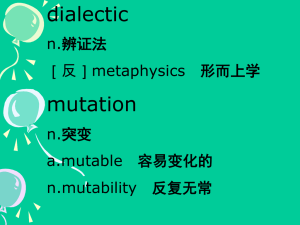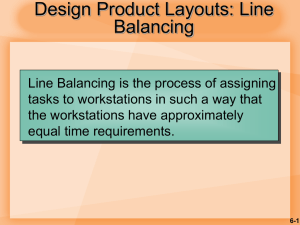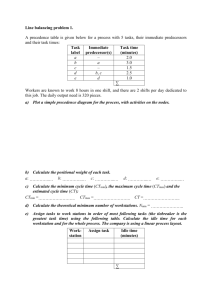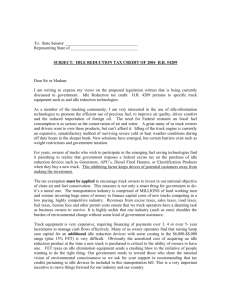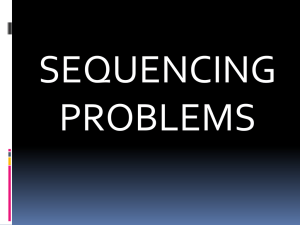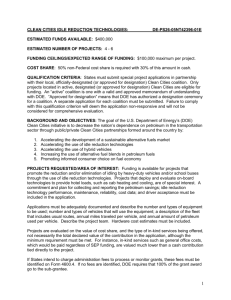Line Balancing & Project Management Exercises
advertisement
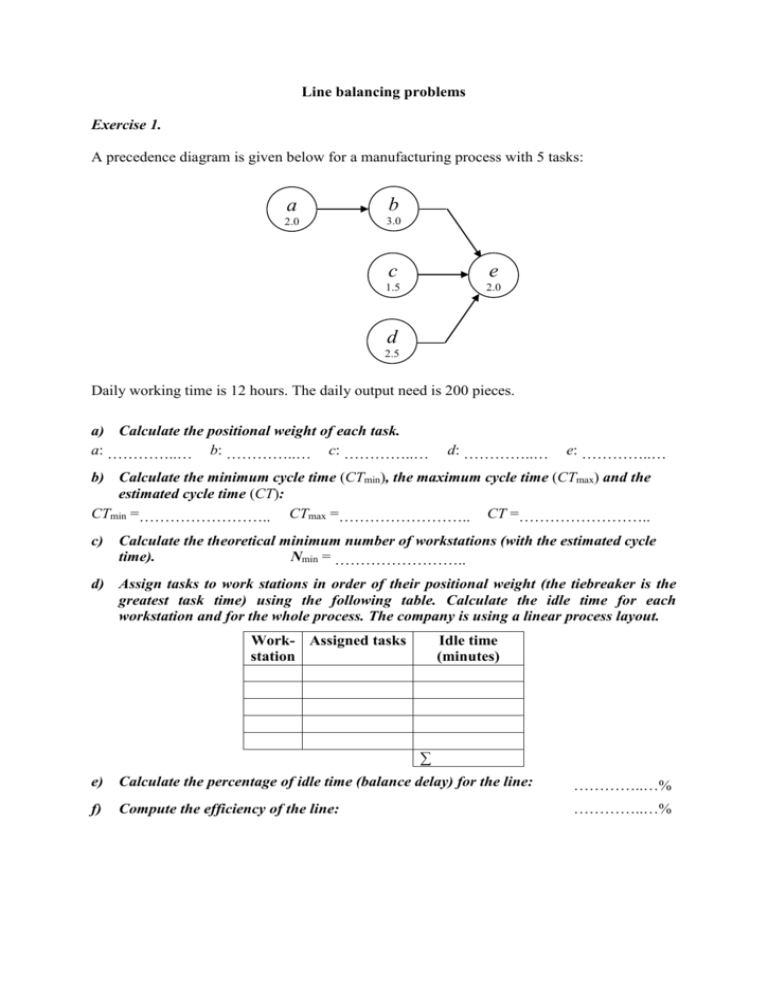
Line balancing problems Exercise 1. A precedence diagram is given below for a manufacturing process with 5 tasks: a b 2.0 3.0 c e 1.5 2.0 d 2.5 Daily working time is 12 hours. The daily output need is 200 pieces. a) Calculate the positional weight of each task. a: …………..… b: …………..… c: …………..… d: …………..… e: …………..… b) Calculate the minimum cycle time (CTmin), the maximum cycle time (CTmax) and the estimated cycle time (CT): CTmin =…………………….. CTmax =…………………….. CT =…………………….. c) Calculate the theoretical minimum number of workstations (with the estimated cycle time). Nmin = …………………….. d) Assign tasks to work stations in order of their positional weight (the tiebreaker is the greatest task time) using the following table. Calculate the idle time for each workstation and for the whole process. The company is using a linear process layout. Work- Assigned tasks station Idle time (minutes) ∑ e) Calculate the percentage of idle time (balance delay) for the line: …………..…% f) Compute the efficiency of the line: …………..…% Solution for problem 1. a) Positional weights: a: 7.0 b: 5.0 c: 3.5 d: 4.5 e: 2.0 b) CTmin = the longest task time = 3.0 minutes CTmax = sum of all the task times = 11.0 minutes CT = (operating time per day) / (desired output per day) = (12 hrs × 60 mins) / 200 pieces = 3.6 mins c) Nmin = (sum of all the task times) / (actual cycle time) = 11 / 3.6 = 3.06 = 4 work stations d) Workstation 1 2 3 4 Assign task Idle time (minutes) 1.6 0.1 1.1 0.6 1.6 a, c d b e ∑ 3.4 e) Percentage of idle time (balance delay) for the line: (idle time per cycle) / [Nactual × (cycle time)] = 3.4 / (4 × 3.6) = 23.61% f) Efficiency of the line = 1 – (percentage of idle time) = 76.39% Exercise 2. A precedence diagram is given below for a manufacturing process with 5 tasks: a d 2.0 3.0 b e f 1.5 1.5 2.0 c 2.0 Daily working time is 14 hours. The daily output need is 210 pieces. a) Calculate the positional weight of each task. a: …………..… b: …………..… c: …………..… d: …………..… e: …………..… f: …………..… b) Calculate the minimum cycle time (CTmin), the maximum cycle time (CTmax) and the estimated cycle time (CT): CTmin =…………………….. CTmax =…………………….. CT =…………………….. c) Calculate the theoretical minimum number of workstations (with the estimated cycle time). Nmin = …………………….. d) Assign tasks to work stations in order of the most following tasks (the tiebreaker is their positional weight) using the following table. Calculate the idle time for each workstation and for the whole process. The company is using a linear process layout. Work- Assigned tasks station Idle time (minutes) ∑ e) Calculate the percentage of idle time (balance delay) for the line: …………..…% f) Compute the efficiency of the line: …………..…% Solution for problem 2. a) Positional weights: a: 7.0 b: 5.0 c: 5.5 d: 5.0 e: 3.5 f: 2.0 b) CTmin = the longest task time = 3.0 minutes CTmax = sum of all the task times = 12.0 minutes CT = (operating time per day) / (desired output per day) = (14 hrs × 60 mins) / 210 pieces = 4.0 mins c) Nmin = (sum of all the task times) / (actual cycle time) = 12 / 4 = 3 workstations d) Workstation 1 2 3 4 Assign task Idle time (minutes) 2.0 0.0 2.5 1.0 1.0 2.0 a, c b, e d f ∑ 4.0 e) Percentage of idle time (balance delay) for the line: (idle time per cycle) / [Nactual × (cycle time)] = 4.0 / (4 × 4.0) = 25.00% f) Efficiency of the line = 1 – (percentage of idle time) = 75.00% Exercise 3. A precedence diagram is given below for a manufacturing process with 5 tasks: a c 1.0 1.5 b d e 1.0 1.0 2.0 Daily working time is 16 hours. The daily output need is 300 pieces. a) Calculate the positional weight of each task. a: …………..… b: …………..… c: …………..… d: …………..… e: …………..… b) Calculate the minimum cycle time (CTmin), the maximum cycle time (CTmax) and the estimated cycle time (CT): CTmin =…………………….. CTmax =…………………….. CT =…………………….. c) Calculate the theoretical minimum number of workstations (with the estimated cycle time). Nmin = …………………….. d) Assign tasks to work stations in order of the most following tasks (the tiebreaker is the greatest positional weight) using the following table. Calculate the idle time for each workstation and for the whole process. The company is using a linear process layout. Work- Assigned tasks station Idle time (minutes) ∑ e) Calculate the percentage of idle time (balance delay) for the line: …………..…% f) Compute the efficiency of the line: …………..…% Solution for problem 3. a) Positional weights: a: 4.5 b: 4.0 c: 3.5 d: 3.0 e: 2.0 b) CTmin = the longest task time = 2.0 minutes CTmax = sum of all the task times = 6.5 minutes CT = (operating time per day) / (desired output per day) = (16 hrs × 60 mins) / 300 pieces = 3.2 mins c) Nmin = (sum of all the task times) / (actual cycle time) = 6.5 / 3.2 = 2.03 = 3 workstations d) WorkAssign task station 1 a, b, d 2 c 3 e Idle time (minutes) 2.2 1.2 0.2 1.7 1.2 ∑ 3.1 e) Percentage of idle time (balance delay) for the line: (idle time per cycle) / [Nactual × (cycle time)] = 3.1 / (3 × 3.2) = 32.29 % f) Efficiency of the line = 1 – (percentage of idle time) = 67.71% Project management exercises Exercise 1. The table below contains data on project activities: Activity Activity duration a 2 b 3 c 1 d 2 e 4 a) Plot the project’s AoA diagram. Immediate predecessor – – a b, c d b) Plot the project’s AoN diagram. c) Identify all paths and their duration: ……………………………………………………………………………………………… d) Identify the critical path(s) and all the critical activities CP: …………………………; critical activities: …………………………………………. TPT = ………………………. e) Calculate the Total Project Time. f) Identify and localize the floats (total float = TF): activity TF Solution for problem 1 a) Plot the project’s AoA diagram. 2 1 2 c a 3 b 1 3 2 d 4 4 e 5 b) Plot the project’s AoN diagram. a c 2 1 START d e 2 4 FINISH b 3 c) Identify all paths and their duration: a-c-d-e = 9; b-d-e = 9 ………………………………………………………… d) Identify the critical path(s) and all the critical activities CP: both are critical; critical activities: all are critical e) Calculate the Total Project Time. TPT = 9 f) Identify and localize the floats (total float = TF): there is no float, because every activity is critical activity - - - - - - TF - - - - - - Exercise 2. The table below contains data on project activities: Activity Activity duration a 2 b 3 c 2 d 2 e 4 f 2 g 1 a) Plot the project’s AoA diagram. Immediate predecessor – a a b c d, e d, e b) Plot the project’s AoN diagram. c) Identify all paths and their duration: ……………………………………………………………………………………………… d) Identify the critical path(s) and all the critical activities CP: …………………………; critical activities: …………………………………………. TPT = ………………………. e) Calculate the Total Project Time. f) Identify and localize the floats (total float = TF): activity TF Solution for problem 2 a) Plot the project’s AoA diagram. 1 2 a 2 3 b 3 2 c 4 2 d 4 e 5 1 g 2 f 7 6 b) Plot the project’s AoN diagram. b d f 3 2 2 a START FINISH 2 c e g 2 4 1 c) Identify all paths and their duration: a-b-d-f = 9; a-b-d-g = 8; a-c-e-f = 10; a-c-e-g = 9 d) Identify the critical path(s) and all the critical activities CP: a-c-e-f = 10 because it is the longest; critical activities: a, c, e, f e) Calculate the Total Project Time. TPT = 10 f) Identify and localize the floats (total float = TF): activity b d g - - - TF 1 1 1 - - - Exercise 3. The table below contains data on project activities: Activity Activity duration a 1 b 2 c 1 d 3 e 3 f 2 a) Plot the project’s AoA diagram. Immediate predecessor – a a b b, c e, d b) Plot the project’s AoN diagram. c) Identify all paths and their duration: ………………………………………………………………………………………… d) Identify the critical path(s) and all the critical activities CP: …………………………; critical activities: ……………………………………. e) Calculate the Total Project Time. TPT = ………………………. f) Identify and localize the floats (total float = TF): activity TF Solution for problem 3 a) Plot the project’s AoA diagram. 1 1 a 2 3 2 b 1 c 4 3 d 2 f 5 7 3 e b) Plot the project’s AoN diagram. START b d 2 3 a f 1 2 c e 1 3 FINISH c) Identify all paths and their duration: a-b-d-f = 8; a-b-e-f = 8; a-c-e-f = 7 d) Identify the critical path(s) and all the critical activities CP: a-b-d-f; a-b-e-f because these are the longest; critical activities: a, b, d, e, f e) Calculate the Total Project Time. TPT = 8 f) Identify and localize the floats (total float = TF): activity c - - - - - TF 1 - - - - -

